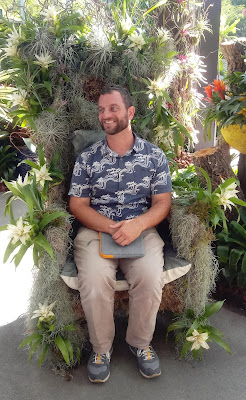By Lonnie Burstein Hewitt. Photos by Maurice Hewitt.
 |
Inside
the Mingei: the Frances Hamilton White Art Library, with Nakashima furniture on
both sides of the glass wall. |
At
9 o’clock on the sunless Friday morning preceding Labor Day weekend, there was
sunshine in the hearts of more than 100 people gathered in Balboa Park’s
Alcazar Garden, eagerly awaiting the grand re-opening of the Mingei International Museum, which has been undergoing major reconstruction for the past three
years.
Besides
representatives of local media, the crowd included supporters and friends of
the Museum, and speakers included Mayor Todd Gloria and the two main movers and
shakers of the project: Mingei Director/CEO Rob Sidner and architect Jennifer
Luce.
 |
Rob
Sidner addressing the crowd at the museum’s new West Entrance in Alcazar
Garden, with the origami crane curtain behind him. Architect Jennifer Luce is
second from left in the lineup of speakers, with the Niki de Sainte Phalle
mosaic The Poet & His Muse spreading wings over all. (Niki’s beloved Nikigator has been on vacation at Liberty Station but will be back outside
the main entrance soon.) |
Sidner,
praised by all for his leadership, patience and spirit during the seven years
of considering and implementing the museum’s transformation, spoke of the Three
A’s they kept always in mind: Access, Art, and Architecture. “We invite
visitors to explore, engage and connect with art and one another,” he said,
noting that the main floor—the Commons, which would always have free
admission—was meant to be a public living room where people can gather for good
food and conversation.
He
and Luce both stressed the idea of inclusiveness. “We can barely wait for you
all to make this place your place,” said the architect.
Decorating
the new garden-side entrance was a curtain of origami cranes, made by museum
volunteers. Origami cranes are said to symbolize success and good fortune, bringing
in good energy with their folded-paper wings. Once speeches were over, the
curtain was parted to let everyone in.
Not
all of the many features of the new Mingei were on view inside. A number of the
large-scale pieces designed to enhance the architecture—all commissioned from
accomplished women artists—were not fully installed, and we weren’t able to see
the lower level, with its high-design theater—formerly a loading dock—where Art
of Elan would be performing that Sunday.
 |
The
handcrafted Artifact Restaurant Bar. (Note the ceiling, designed by Jennifer
Luce.) |
But
as we walked into the building, the sense of spaciousness was overwhelming, a
feeling that pervaded our entire half-hour stay before the doors were opened to
the public. The Artifact restaurant was not diner-ready, but the 30-foot
handcrafted bar was impressive. And the two new exhibitions upstairs—Global
Spirit and Humble Spirit—had many delights, while the
glass-fronted Art Library and the dramatic Founder’s Gallery gave us a chance
to admire the craftsmanship of tables, chairs and benches from the studio of master
woodworker George Nakashima (1905-1990) in New Hope, Pennsylvania.
 |
The
Global Spirit exhibition, featuring over 200 pieces of folk art from over
20 different countries. |
 |
Wooden
armadillo, made in Brazil, part of the Global Spirit exhibit. |
 |
Mexican
rooster, made of scrap metal, backed by other pieces from Global Spirit. |
 |
| Indian elephant, made of papier mache and
bamboo. (Global Spirit) |
 |
| Tin Lantern from Mexico, Japanese cotton towels
on wall, part of the Humble Spirit exhibit, showcasing notable
art created from humble materials. |
 |
| Lifesize figures of a late-20th-century
wedding party, made of papier mache and dung, from Bihar, India. (Humble
Spirit) |
 |
| Detail: Two figures from wedding party
sculpture. |
The Mingei’s
55-million-dollar renovation has so far raised $47 million from about 700
contributors—some giving as little as $5, some up to $15 million—and it’s
definitely a place you’ll want to see for yourself. There are indoor and
outdoor spaces to explore at your leisure, keeping an eye out for artful details
on walls and ceilings. Artifact restaurant, opening in mid-October, promises to
be a real palate-pleaser, and don’t miss the expansive park views from the
upper decks.
 |
| Entry to the Board Room, aka Founders Gallery. |
 |
In the Courtyard: Hand-twisted
bronze picket fence by Jennifer Luce with A. Zahner/Zahner Labs. |
About
the Mingei:
Originally founded in 1978 by ceramicist/art professor Martha Longenecker
(1920-2013), the Mingei began as a small space in University Towne Centre dedicated
to Japanese folk art. Its name means “art of the people,” but over the
years, it embraced the folk art of many cultures, and moved into Balboa Park in
1996. A nonprofit institution, the museum honors anonymous craftsmen from
ancient times as well as contemporary designers, and welcomes over 100,000
visitors a year.
Mingei
International Museum
HOURS:
Sat-Wed, 10 am-5 pm. Thur-Fri, 10 am-8 pm.
ADMISSION:
Adults: $14. Seniors, students, military: $10. Under age 18: Free.
Commons
Level: Free to all. www.mingei.org
Lonnie Burstein Hewitt is an
award-winning author/lyricist/playwright who has written about arts and
lifestyle for the La Jolla Light and other local media for over a dozen years.
You can reach her at hew2@sbcglobal.net.






























